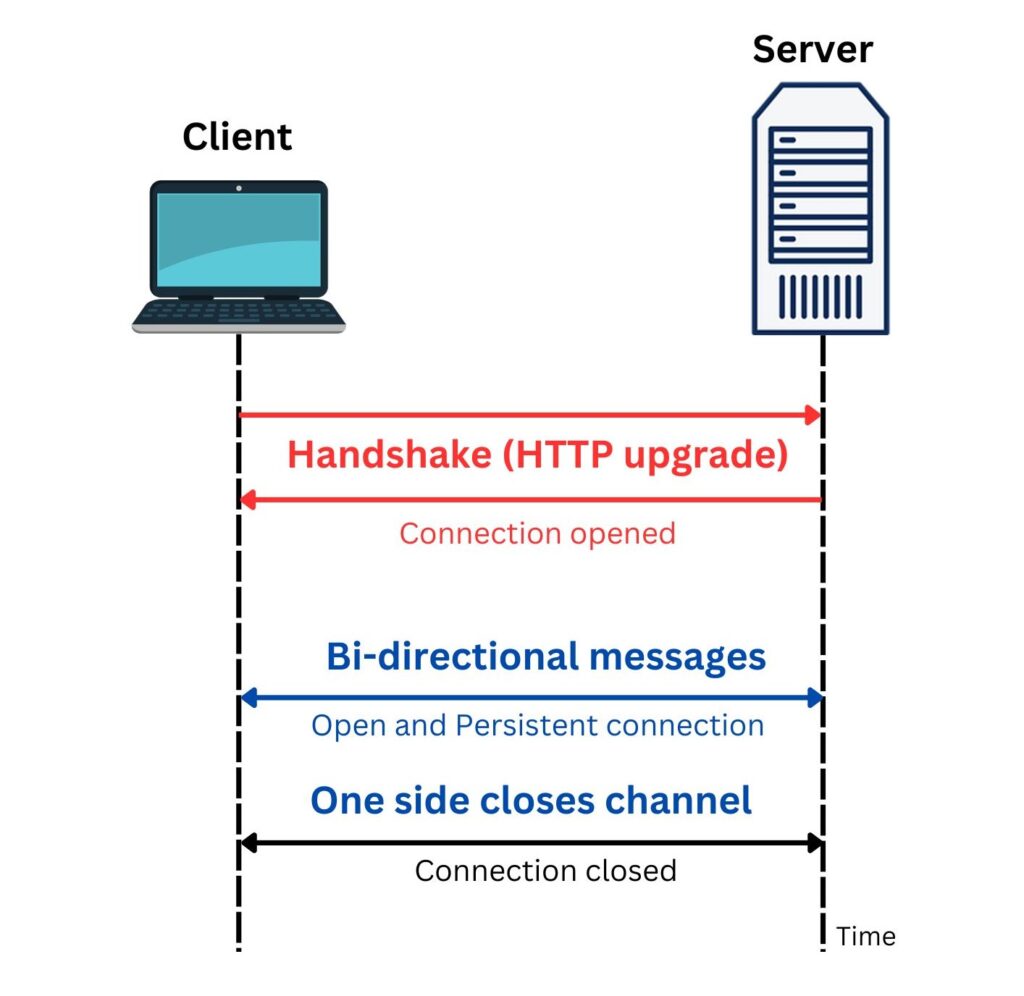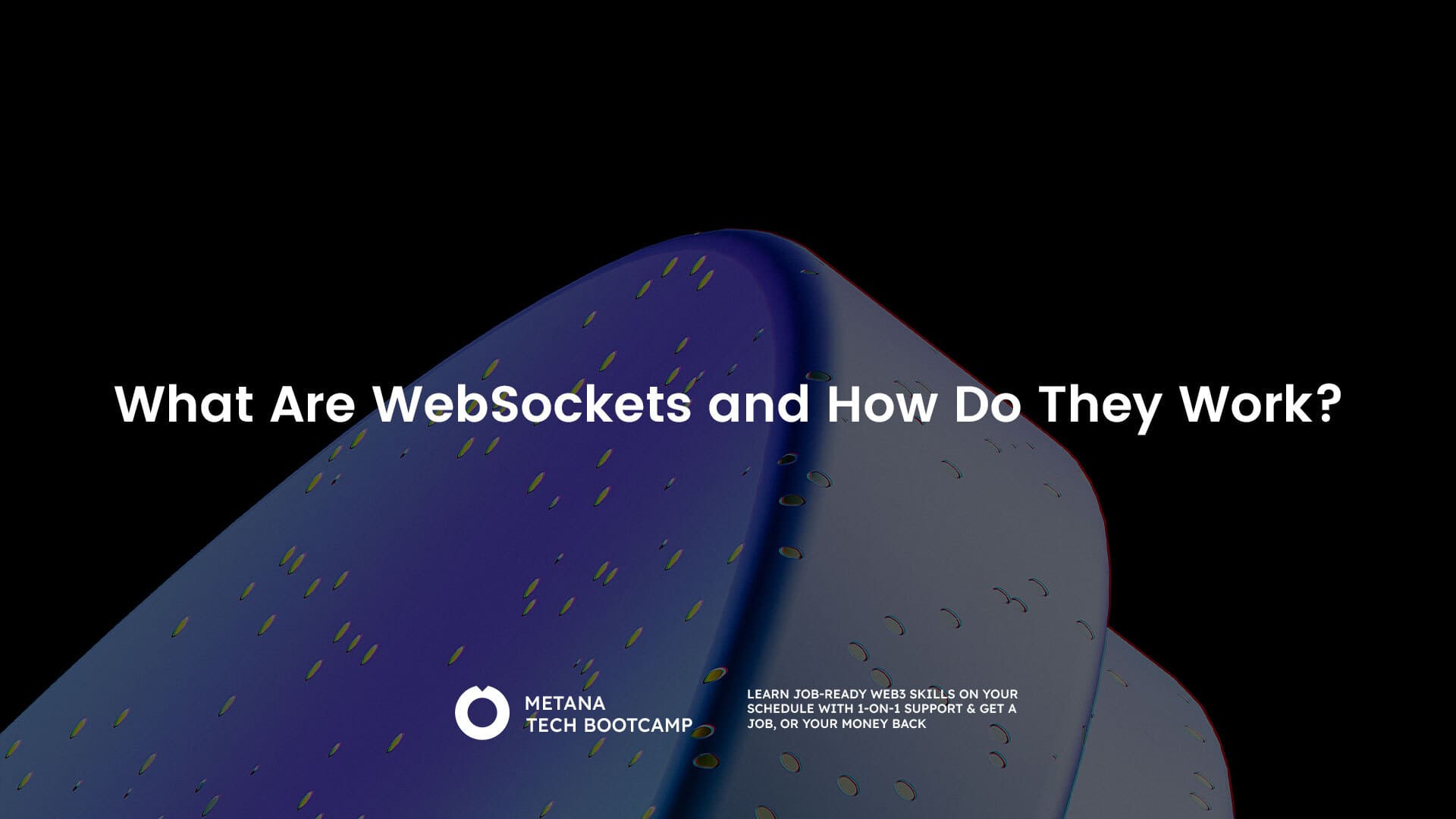TL;DR
WebSockets are a protocol that enables real-time, bidirectional communication between clients and servers over a single persistent connection. Unlike HTTP’s request-response model, WebSockets allow both parties to send data simultaneously without needing new connections each time.
Key Points:
- How it works: Starts with an HTTP handshake, then upgrades to a persistent TCP connection that stays open
- vs HTTP: HTTP is one-way and stateless; WebSockets are bidirectional and maintain persistent connections
- Benefits: Real-time communication, low latency, efficient data transfer, better user experience
- Drawbacks: More complex to implement, requires more server resources, security considerations
- Common uses: Chat apps, real-time dashboards, online gaming, financial trading platforms, live notifications
Security: Use WSS (WebSocket Secure) over TLS/SSL for encrypted connections, implement proper authentication and authorization.
In this comprehensive guide, we will explore the what are WebSockets, how they work, their advantages, and common use cases. Whether you are a beginner or an experienced developer, this article will provide you with a solid foundation to understand and utilize WebSockets effectively.
What are WebSockets?
WebSocket is a protocol for real-time, bidirectional communication between clients and servers over a single, long-lived connection. Unlike traditional HTTP requests, which are unidirectional and require a new connection for each request, WebSockets enable continuous communication between the client and server. This persistent connection allows for instant data transfer and eliminates the need for frequent polling or refreshing of web pages.
What is a WebSocket Protocol?
The WebSocket protocol is the foundation of WebSockets and defines the rules and conventions for establishing and maintaining a WebSocket connection. It operates on top of the Transmission Control Protocol (TCP), which ensures reliable and ordered transmission of data between the client and server.
What are the main components of WebSocket protocol?
The WebSocket protocol works in two main phases:
1. The Handshake Phase
- The client and server first need to “shake hands” using HTTP to establish trust and compatibility
- During this initial exchange, they send specific headers back and forth to negotiate connection details and confirm both sides are ready to switch from regular HTTP to WebSocket communication
- This handshake ensures both parties agree on the protocol version, extensions, and other connection parameters
2. The Communication Phase
- Once the handshake is successfully completed, the HTTP connection upgrades to a full WebSocket connection
- Both the client and server can now send messages back and forth instantly, without the usual HTTP request-response cycle limitations
- This enables true real-time, bidirectional communication where either side can send a message at any time and the other will receive it immediately
This two-step process makes WebSockets essential for modern applications, especially in Web3 development where real-time data feeds are crucial for DeFi applications, NFT marketplaces, and blockchain interactions.
WebSockets vs. HTTP
In the world of web communication, HTTP and WebSockets serve different purposes. Here’s a concise overview:
HTTP:
- One-way street: Requests and responses flow in one direction, making it suitable for static content delivery.
- Stateless: Each interaction is independent, with no persistent connection.
- Request-response model: Delays and overhead occur due to repeated requests.
- Limited real-time capability: Clients can only initiate requests, limiting dynamic interaction.
WebSockets:
- Bidirectional communication: Real-time, simultaneous communication between client and server.
- Persistent connection: Once established, the connection remains open for continuous data flow.
- Ideal for real-time applications: Chat platforms, gaming, and live data streaming benefit from instant updates.
- Dynamic and responsive: Both client and server can actively participate in communication.
You can choose HTTP for static websites and WebSockets for applications requiring instant two-way communication and dynamic responsiveness. Think of HTTP as a waiter at a restaurant and WebSockets as a lively conversation at a coffee shop. Consider the strengths of each protocol for your specific needs.
How Do WebSockets Work?
WebSockets work by establishing a persistent connection between the client and server over a single TCP socket. This connection remains open as long as both parties desire, allowing for continuous bidirectional communication. To establish a WebSocket connection, a process called handshaking takes place between the client and the server. Handshaking ensures that the server and client are in sync and ready to communicate using the WebSocket protocol. The handshaking process involves an HTTP request and response exchange.
Here is a simplified overview of how the WebSocket protocol works:
- Client Request: The client initiates the WebSocket connection by sending an HTTP GET request to the server. This request includes specific headers, such as the
Upgradeheader to indicate the WebSocket handshake and theSec-WebSocket-Keyheader, which contains a randomly generated value encoded in Base64. This process is essential for developers working with Web3.js connections to Ethereum, where real-time blockchain data is crucial.
- Server Response: Upon receiving the client’s request, the server responds with an HTTP response. This response includes headers such as
Upgradeto indicate the WebSocket handshake response,Sec-WebSocket-Acceptto validate the client’s request, andSec-WebSocket-Protocolto specify the agreed-upon subprotocol if applicable.
- Handshake Completion: If the handshake is successful, the connection is upgraded to the WebSocket protocol. The client and server can now communicate bidirectionally over a single TCP connection. This connection remains open, allowing for real-time, low-latency communication.
Implementing a WebSocket connection
Implementing a WebSocket connection typically involves using a WebSocket library or framework. These libraries provide abstractions and APIs that simplify the process of establishing and managing WebSocket connections. Popular WebSocket libraries include Socket.IO, SignalR, and SockJS.
What happens after it is established?
Once the WebSocket connection is established, data can be sent between the client and server using a framed message protocol. This means that messages are divided into smaller frames for efficient transmission over the WebSocket connection.
What is a WebSocket frame?
A WebSocket frame consists of a header and a payload. The header contains information about the frame, such as the message type, length, and whether it is the final frame in a message. The payload contains the actual message data.
The WebSocket protocol supports various message types, including text, binary, ping, pong, and close.
WebSockets provide a persistent connection, eliminating the need for repetitive polling and reducing network overhead. The WebSocket API allows developers to handle events and send/receive data on the connection, making it easy to build real-time and interactive web applications.

WebSocket Security
WebSocket security is of utmost importance when transmitting sensitive or confidential data over the connection. Here are some key considerations:
- Secure WebSocket Connections: Use the WebSocket Secure (WSS) protocol over TLS/SSL to encrypt data transmission and protect against unauthorized access or tampering.
- Authentication and Authorization: Implement mechanisms to authenticate and authorize clients, ensuring that only authorized users can establish connections or access specific resources. This can involve using authentication tokens, API keys, or other secure credential management techniques.
- Secure Coding Practices: Follow secure coding practices to mitigate potential security vulnerabilities. Regularly update WebSocket libraries and frameworks to address any known security issues.
- Security Audits and Penetration Testing: Conduct regular security audits and penetration testing to identify and address any security weaknesses in WebSocket implementations.
Remember, WebSocket security is crucial for maintaining the confidentiality, integrity, and authenticity of data exchanged over the connection. By implementing secure practices and staying vigilant, you can ensure a robust and secure WebSocket communication environment.
Benefits and Drawbacks Of WebSockets
| Benefits | Drawbacks |
|---|---|
| Real-time Interactivity: WebSockets enable instant updates and real-time data transfer, making them ideal for applications like live chat, online gaming, and stock trading. | Complexity: Implementing and maintaining WebSockets requires more technical expertise compared to traditional HTTP. |
| Bi-directional Communication: With WebSockets, both the server and client can send and receive data simultaneously, fostering dynamic and interactive experiences. | Security Considerations: Encryption and authentication are crucial to protect sensitive data and prevent unauthorized access. |
| Efficiency and Low Latency: WebSockets maintain a persistent connection, reducing overhead and enabling faster data transfer with low latency. | Browser Compatibility: Ensure that the target audience’s browsers support WebSockets to avoid compatibility issues. |
| Responsive User Experience: By facilitating dynamic and reactive interactions, WebSockets keep users engaged and immersed in the application. | Increased Server Load: Real-time communication demands continuous server resources, necessitating careful planning and scaling. |
| Scalability Potential: Proper server architecture allows WebSockets to handle large volumes of data efficiently. | Limited Offline Support: WebSockets rely on continuous connectivity, making offline usage challenging. |
Common Use Cases for WebSockets
WebSockets have become an integral part of modern web application development and are widely used in various real-time and interactive scenarios. Some common use cases for WebSockets include:
- Chat applications: WebSockets enable real-time messaging and chat features, allowing users to communicate instantly without the need for page refreshes.
- Real-time dashboards: WebSockets are used to display real-time data updates on dashboards, such as stock market prices, social media feeds, or monitoring systems.
- Multiplayer online gaming: WebSockets provide the necessary infrastructure for real-time multiplayer gaming, enabling players to interact and communicate in real-time.
- Collaborative tools and whiteboards: WebSockets facilitate real-time collaboration on shared projects, allowing multiple users to work together simultaneously.
- Live notifications and alerts: WebSockets can be used to deliver instant notifications and alerts to users, such as email or chat notifications, system alerts, or event reminders.
- Financial trading platforms: WebSockets enable real-time updates of stock prices, market data, and trading information, allowing traders to make timely decisions based on the latest information.
Conclusion
WebSockets have revolutionized web development, enabling real-time, bidirectional communication between clients and servers. They provide a low-latency, efficient, and scalable solution for building interactive and responsive web applications.
Remember to implement security measures, monitor WebSocket traffic, and follow best practices to ensure the performance, scalability, and security of your WebSocket applications. With WebSockets, you can unlock the full potential of real-time communication on the web.
Curious about Web 3.0? Let’s get started here.

FAQs
What is a WebSocket?
- A WebSocket is a communication protocol that provides a full-duplex, bidirectional communication channel over a single long-lived TCP connection. It enables real-time data transfer between a client (like a web browser) and a server.
How does a WebSocket differ from HTTP?
- Unlike HTTP, which is a request-response protocol where the client must initiate all communications, WebSockets allow for continuous two-way communication after the initial handshake. This makes WebSockets ideal for real-time applications like live chats and online gaming.
Is WebSocket secure?
- Yes, when using WebSockets over TLS/SSL (denoted as
wss://in the URL), the data transferred is encrypted, making it secure for sensitive communications. This is similar to the security provided by HTTPS for HTTP connections.
Can WebSockets work with all web servers and browsers?
- Most modern web servers and browsers support WebSockets. However, for full compatibility, both the server and the client (browser) must implement the WebSocket protocol.
Do WebSockets work across firewalls and proxies?
- WebSockets can work across firewalls and proxies, but it depends on the network configuration. Some proxies and firewalls might block WebSocket traffic if they are configured to only allow specific types of traffic.
What’s the difference between WebSockets and AJAX?
- AJAX (Asynchronous JavaScript and XML) is a technique for creating asynchronous web applications using a mix of HTML, CSS, JavaScript, and the XMLHttpRequest object. Unlike WebSockets, AJAX uses HTTP for communication and is primarily used for client-initiated requests and server responses.
Can WebSockets replace REST APIs?
- WebSockets and REST APIs serve different purposes. REST is stateless and follows a request-response model, typically over HTTP, ideal for CRUD operations. WebSockets, on the other hand, offer real-time bidirectional communication. For many applications, a combination of both is often the best solution.
Are WebSockets suitable for all web applications?
- Not necessarily. While WebSockets are excellent for real-time, bidirectional communication, they may be overkill for web applications that do not require real-time updates or have low client-server interaction.
How does WebSocket impact server load compared to HTTP?
- WebSockets can reduce server load for real-time applications, as they eliminate the overhead of repeatedly opening and closing connections, unlike HTTP. However, they might increase server load in terms of maintaining open connections for each client.
What programming languages support WebSockets?
- WebSockets are supported in various programming languages, including JavaScript for clients (browsers) and Node.js, Java, Python, C#, and others for server-side implementation. The choice of language depends on the specific requirements and environment of the application.




